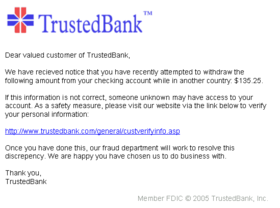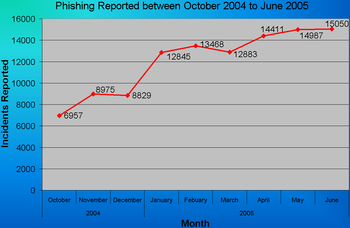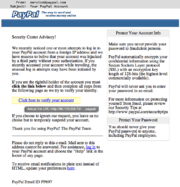Phishing
2007 Schools Wikipedia Selection. Related subjects: Websites and the Internet
In computing, phishing is a criminal activity using social engineering techniques. Phishers attempt to fraudulently acquire sensitive information, such as passwords and credit card details, by masquerading as a trustworthy person or business in an electronic communication. Phishing is typically carried out using email or an instant message, although phone contact has been used as well. Attempts to deal with the growing number of reported phishing incidents include legislation, user training, and technical measures.
The first recorded mention of phishing is on the alt.online-service.america-online Usenet newsgroup on January 2, 1996, although the term may have appeared even earlier in the print edition of the hacker magazine 2600. The term phishing is a variant of fishing, probably influenced by phreaking, and alludes to the use of increasingly sophisticated lures to "fish" for users' financial information and passwords. The word may also be linked to leetspeak, in which ph is a common substitution for f. The popular theory that it is a portmanteau of password harvesting is an example of folk etymology.
Early phishing on AOL
Those who would later phish on AOL during the 1990s originally used fake, algorithmically generated credit card numbers to create accounts on AOL, which could last weeks or even months. After AOL brought in measures in late 1995 to prevent this, early AOL crackers resorted to phishing for legitimate accounts.
Phishing on AOL was closely associated with the warez community that exchanged pirated software. A phisher might pose as an AOL staff member and send an instant message to a potential victim, asking him to reveal his password. In order to lure the victim into giving up sensitive information the message might include text such as "verify your account" or "confirm billing information". Once the victim had submitted his password, the attacker could access and use the victim's account for criminal purposes, such as spamming. Both phishing and warezing on AOL generally required custom-written programs, such as AOHell. Phishing became so prevalent on AOL that they added a line on all instant messages stating: "no one working at AOL will ask for your password or billing information".
After 1997, AOL's policy enforcement with respect to phishing and warez became stricter and forced pirated software off AOL servers. AOL simultaneously developed a system to promptly deactivate accounts involved in phishing, often before the victims could respond. The shutting down of the warez scene on AOL caused most phishers to leave the service, and many phishers — often young teens — grew out of the habit.
Recent phishing attempts
More recent phishing attempts have targeted the customers of banks and online payment services. E-mails supposedly from the Internal Revenue Service have also been used to glean sensitive data from U.S. taxpayers. While the first such examples were sent indiscriminately in the hope of finding a customer of a given bank or service, recent research has shown that phishers may in principle be able to establish what bank a potential victim has a relationship with, and then send an appropriate spoofed email to this victim.. Targeted versions of phishing have been termed spear phishing. Social networking sites are also a target of phishing, since the personal details in such sites can be used in identity theft. Experiments show a success rate of over 70% for phishing attacks on social networks.
Phishing techniques
Most methods of phishing use some form of technical deception designed to make a link in an email appear to belong to the spoofed organization. Misspelled URLs or the use of subdomains are common tricks used by phishers, such as this example URL, http://www.yourbank.com.example.com/. Another common trick is to make the anchor text for a link appear to be a valid URL when the link actually goes to the phishers' site.
One method of spoofing links use web addresses containing the @ symbol, which are used to include a username and password in a web URL (contrary to the standard). For example, the link http://www.google.com@members.tripod.com/ might deceive a casual observer into believing that the link will open a page on www.google.com, whereas the link actually directs the browser to a page on members.tripod.com, using a username of www.google.com; were there no such user, the page would open normally. Such URLs were subsequently disabled in Internet Explorer, with the Mozilla and Opera web browsers opting instead to present a warning message and give users the option of continuing to the site or cancelling.
Some phishing scams use JavaScript commands in order to alter the address bar. This is done either by placing a picture of the legitimate entity's URL over the address bar, or by closing the original address bar and opening a new one containing the legitimate URL.
In another popular method of phishing, an attacker uses a bank or service's own scripts against the victim. These types of attacks (known as cross-site scripting) are particularly problematic, because they direct the user to sign in at their bank or service's own web page, where everything from the web address to the security certificates appears correct. In reality, the link to the website is crafted to carry out the attack, although it is very difficult to spot without specialist knowledge. Just such a flaw was used in 2006 against PayPal.
A further problem with URLs has been found in the handling of Internationalized domain names (IDN) in web browsers, that might allow visually identical web addresses to lead to different, possibly malicious, websites. Despite the publicity surrounding the flaw, known as IDN spoofing or a homograph attack, no known phishing attacks have yet taken advantage of it.
Not all phishing attacks require a fake website. In an incident in 2006, messages that claimed to be from a bank told users to dial a phone number regarding a problem with their bank account. Once the phone number was dialed, prompts told users to enter their account numbers and PIN. The number was provided by a Voice over IP provider.
Phishing examples
PayPal phishing example
In an example PayPal phish (right), spelling mistakes in the email and the presence of an IP address in the link (visible in the tooltip under the yellow box) are both clues that this is a phishing attempt. Another giveaway is the lack of a personal greeting, although the presence of personal details is not a guarantee of legitimacy.
SouthTrust Bank example
In this second example, targeted at SouthTrust Bank users, the phisher has used an image to make it harder for anti-phishing filters to detect by scanning for text commonly used in phishing emails.
From: SouthTrust <support_id_99583160@southtrust.com>To: john.smith@example.comSubject: SouthTrust Bank: Important NotificationDate: Thu, 16 Jun 2005 23:56:30 -0200 (22:56 BRT)
Damage caused by phishing
The damage caused by phishing ranges from loss of access to email to substantial financial loss. This style of identity theft is becoming more popular, because of the ease with which unsuspecting people often divulge personal information to phishers, including credit card numbers, social security numbers, and mothers' maiden names. There are also fears that identity thieves can obtain some such information simply by accessing public records.
Once this information is acquired, the phishers may use a person's details to create fake accounts in a victim's name, ruin a victim's credit, or even prevent victims from accessing their own accounts.
It is estimated that between May 2004 and May 2005, approximately 1.2 million computer users in the United States suffered losses caused by phishing, totaling approximately $929 million USD. U.S. businesses lose an estimated $2 billion USD a year as their clients become victims. In the United Kingdom losses from web banking fraud — mostly from phishing — almost doubled to £23.2m in 2005, from £12.2m in 2004, while 1 in 20 users claimed to have lost out to phishing in 2005.
Anti-phishing
There are several different techniques to combat phishing, including legislation and technology created specifically to protect against phishing.
Social responses
One strategy for combating phishing is to train users to deal with phishing attempts. User education can be promising, especially where training provides direct feedback to the user on his success (or otherwise). One newer phishing tactic, which uses phishing emails targeted at a specific company, known as spear phishing, has been harnessed to train users at various locations, including West Point Military Academy. In a June 2004 experiment with spear phishing, 80% of 500 West Point cadets who were sent a fake email were tricked into revealing personal information.
Users who are contacted about an account needing to be "verified" can take steps to avoid phishing attempts by contacting the company that is the subject of the email to check that the email is legitimate or by typing in a trusted web address for the company's website into the address bar of their browser to bypass the link in the suspected phishing message.
Nearly all legitimate email messages from companies to their customers will contain an item of information that is not readily available to phishers. Some companies, like PayPal, always address their customers by their username in emails, so if an email addresses a user in a generic fashion ("Dear PayPal customer") it is likely to be an attempt at phishing. Emails from banks and credit card companies will often include partial account numbers. Therefore, one should always be suspicious if the message does not contain specific personal information. Phishing attempts in early 2006, however, used such highly personalized information, making it unsafe to rely on personal information alone as a sign that a message is legitimate. Further, another recent study concluded in part that the presence of this information does not significantly affect the success rate of phishing attacks, suggesting that most users do not pay attention to such details anyway.
The Anti-Phishing Working Group, an industry and law enforcement association, has suggested that conventional phishing techniques could become obsolete in the future as people are increasingly aware of the social engineering techniques used by phishers. They propose that pharming and other uses of malware will become more common tools for stealing information.
Technical responses
Anti-phishing software is available that may identify phishing contents on websites, act as a toolbar that displays the real domain name for the visited website, or spot phishing attempts in email. Microsoft's new IE7 browser, Mozilla's Firefox 2, and Opera from version 9.1 will include a form of anti-phishing technology, by which a site may be checked against a list of known phishing sites. If the site is a suspect the software may either warn a user or block the site outright. Firefox 2 uses Google anti-phishing software, which may also be installed under IE6. Spam filters also help protect users from phishers, because they reduce the number of phishing-related emails that users receive. An approach introduced in mid-2006 (similar in principle to using a hosts file to block web adverts) involves switching to using a special DNS service that filters out known phishing domains, which will work with any browser.
Sites have added verification tools that allow users to see a secret image that the user selected in advance; if the image does not appear, then the site is not legitimate. Bank of America uses this together with challenge questions, which ask the user for information that should be known only to the user and the bank. This feature (and other forms of two-way authentication and two-factor authentication) is still susceptible to attack, such as that suffered by Scandinavian bank Nordea in late 2005.
Monitoring and takedown
Several companies offer banks and other entities likely to suffer from phishing scams 24/7 services to monitor, analyze and assist in shutting down phishing websites. Individuals can contribute by reporting phishing to both volunteer and industry groups, such as PhishTank.
Legal responses
On January 26, 2004, the FTC ( Federal Trade Commission) filed the first lawsuit against a suspected phisher. The defendant, a Californian teenager, allegedly created and used a webpage designed to look like the America Online website, so that he could steal credit card numbers. Other countries have followed the lead of the U.S. by tracing and arresting phishers. A phishing kingpin, Valdir Paulo de Almeida, was arrested in Brazil for leading one of the largest phishing crime rings, which in 2 years stole between $18 and $37 million USD. UK authorities jailed two men in June 2005 for their role in a phishing scam, in a case connected to the US Secret Service Operation Firewall, which targeted notorious "carder" websites. In 2006 eight people were arrested by Japanese police on suspicion of phishing fraud by creating bogus Yahoo Japan Web sites, netting themselves 100 million yen ($870 thousand USD).
In the United States, Democratic Senator Patrick Leahy introduced the Anti-Phishing Act of 2005 on March 1, 2005. The federal anti-phishing bill proposes that criminals who create fake web sites and spam bogus emails in order to defraud consumers could receive a fine up to $250,000 and receive jail terms of up to five years.
Microsoft has also joined the effort to crack down on phishing. On March 31, 2005, Microsoft filed 117 federal lawsuits in the U.S. District Court for the Western District of Washington. The lawsuits accuse " John Doe" defendants of using various methods to obtain passwords and confidential information. March 2005 also saw Microsoft partner with the Australian government to teach law enforcement officials how to combat various cyber crimes, including phishing.. Microsoft announced a planned further 100 lawsuits outside the U.S. in March 2006
AOL reinforced its efforts against phishing in early 2006 with three lawsuits seeking a total of $18 million USD under the 2005 amendments to the Virginia Computer Crimes Act.


